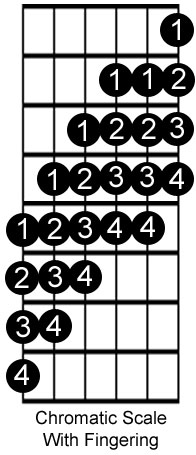While there have been many lessons written on the use of chromatics I was hoping I could impart some of my uses and insights to this somewhat eclectic scale.
Chromatics are commonly used primarily in the jazz genre. In this lesson I'd like to talk about taking this scale and applying to a rock and metal format. In use chromatics are a very cool way to seamlessly connect melodic ideas. Since there are infinite applications for the chromatic scale I'm going to touch on a few ideas to help get the ball rolling and hopefully give some insight. First a little background on the scale itself.
The chromatic scale is a non-diatonic scale, meaning that it has no key center. It consists of twelve consecutive pitches. What's nice is the symmetry of the scale itself. All the pitches are a half step (one fret) away from each other. This makes the scale easy to remember and a lot of fun to play. The Chromatic scale has two written versions, the harmonic version and the melodic version. The only difference between the two is how they are notated. The harmonic variant is written the same ascending and descending. It consists of notes in the major, harmonic minor or melodic minor scales plus the flattened second and sharpened fourth degrees. The melodic version is a bit more nebulous in how its notated. People will generally place the sharps or flats to taste since there is no hard and fast rule. While there has been a lot of controversy on how the scale should be written I'll leave that to the pros. For me, it's all about applying the scale to the guitar! Below you can see a common version of the chromatic scale and its fingering.

Firstly, the chromatic scale is a great tool for creating exercises. There are many ways to manipulate the scale through its different permutations. These exercises can sharpen your alternate picking chops while creating some interesting outside lines and patterns. Let's look at some different ideas starting on E (12th fret low E string).
Example 1 is a simple exercise that can really help lock up the left and right hands and it has a nice cascading effect.

Example 2 shows a descending and ascending sound within the ascent of the scale.

Example 3 shows a string skipping idea which sounds aggressive and angular.

Example 4 takes a pattern and imposes it on the scale creating another melodic idea.

These examples are just starting points. Feel free to experiment and combine these different ideas together and mix them with your own. Playing the scale in reverse is just as effective and can really create some cool jarring effects especially if you manipulate the note sequences. Create your own patterns to impose on the scale and you'll soon see how infinite the possibilities are!
Another thing to explore are the different permutations that can be achieved on each string as you ascend or descend within the scale. I show some ideas below in Example 5.

Some ideas on mixing concepts could be applying one of the single string note sequences above to the string skipping exercise in Example 3. Or take Example 4 and instead of having eight note groupings create odd number groups and apply it over an even time signature. Lots of fun to be had!
While this lesson deals primarily with the chromatic scale as a stand alone scale the next lesson will feature combining chromatics with different techniques and applying it in improvisation.
Thanks for reading!
Greg Rapaport is a seven-string guitarist/bassist whose musical focus is a blend of instrumental progressive-metal and jazz-fusion. Greg has been on three tribute CDs (Led Zeppelin, Jeff Beck, Jimi Hendrix - BHP Productions) and has released three critically acclaimed CDs. Greg is currently teaching in upper Westchester County NY.
His latest instrumental CD is entitled "Homunculus".